Related Research Articles
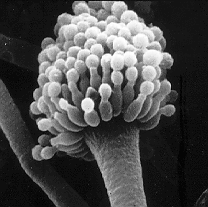
The Eurotiales are an order of sac fungi, also known as the green and blue molds. It was circumscribed in 1980.

The Hypocreales are an order of fungi within the class Sordariomycetes. In 2008, it was estimated that it contained some 237 genera, and 2647 species in seven families. Since then, a considerable number of further taxa have been identified, including an additional family, the Stachybotryaceae. Wijayawardene et al. in 2020 added more families and genera to the order. According to the Catalog of Life, As of April 2021 the Hypocreales contains 6 families, 137 genera, and 1411 species. Hyde et al. (2020a) listed 14 families under Hypocreales, while, Wijayawardene et al. (2022) accepted 15 families in the order, where Cylindriaceae was additionally added. Earlier, Hyde et al. (2020a) had placed Cylindriaceae in class Xylariomycetidae. Samarakoon et al. (2022) agreed. Hence, Cylindriaceae should have been excluded from Hypocreales and placed in Xylariomycetidae. Xiao et al. (2022) recently introduced a new family Polycephalomycetaceae to Hypocreales.

The Leotiomycetes are a class of ascomycete fungi. Many of them cause serious plant diseases.

The Nectriaceae comprise a family of fungi in the order Hypocreales. It was circumscribed by brothers Charles and Louis René Tulasne in 1865. In 2020, an Outline of fungi was produced and listed 70 genera and about 1,336 species.
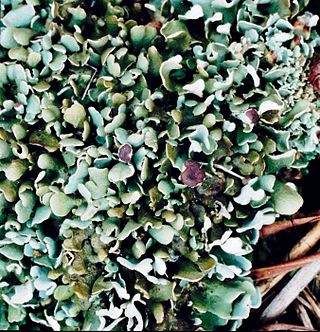
Lecanoromycetes is the largest class of lichenized fungi. It belongs to the subphylum Pezizomycotina in the phylum Ascomycota. The asci of the Lecanoromycetes most often release spores by rostrate dehiscence.

Capnodiales is a diverse order of Dothideomycetes, initially based on the family Capnodiaceae, also known as sooty mold fungi. Sooty molds grow as epiphytes, forming masses of black cells on plant leaves and are often associated with the honeydew secreted by insects feeding on plant sap. This diverse order has been expanded by the addition of several families formerly thought unrelated and now also includes saprobes, endophytes, plant pathogens, lichens and rock-inhabiting fungi. The new additions include the genus Mycosphaerella containing the causal agents of several economically important crop and tree diseases. A small number of these fungi are also able to parasitise humans and animals, including species able to colonise human hair shafts.

Diaporthales is an order of sac fungi.

The Botryosphaeriales are an order of sac fungi (Ascomycetes), placed under class Dothideomycetes. Some species are parasites, causing leaf spot, plant rot, die-back or cankers, but they can also be saprophytes or endophytes. They occur world-wide on many hosts. For example, in China, infections related to Botryosphaeriales have been recorded on numerous hosts such as grapes, Caragana arborescens,Cercis chinensis, Eucalyptus, Chinese hackberry, blueberry, forest trees, and various other woody hosts.

Phyllachorales is a small order of perithecial sac fungi containing mostly foliar parasites. This order lacks reliable morphological characters making taxonomic placement of genera difficult. There is controversy among mycologists as to the boundaries of this order. Family Phaeochorellaceae was added in 2020.

The Lecanoromycetidae are a subclass of fungi in the class Lecanoromycetes. This subclass contains seven orders:

Lichinales is the sole order of ascomycete fungi in the class Lichinomycetes. It contains three families: Gloeoheppiaceae, Lichinaceae, and Peltulaceae. Most species are lichenized. Lichinales was proposed in 1986 by German lichenologists Aino Henssen and Burkhard Büdel. The class Lichinomycetes was created by Valérie Reeb, François Lutzoni and Claude Roux in 2004.

The Pertusariales are an order of fungi in the class Lecanoromycetes. It contains the following families: Coccotremataceae, Icmadophilaceae, Megasporaceae, Microcaliciaceae, Ochrolechiaceae, Pertusariaceae, Varicellariaceae, and Variolariaceae. Many of these fungi form lichens.

The Mycocaliciales are an order of ascomycetous fungi within the subclass Mycocaliciomycetidae and within the class Eurotiomycetes.
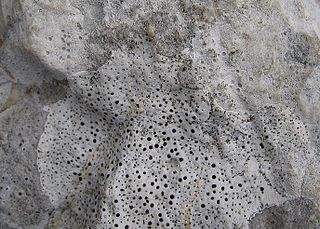
Verrucariales is an order of ascomycetous fungi within the subclass Chaetothyriomycetidae of the class Eurotiomycetes. Although most of the Verrucariales are lichenised, the family Sarcopyreniaceae consists of 11 species of lichenicolous (lichen-dwelling) fungi.

The Pyrenulales are an order of ascomycetous fungi within the class Eurotiomycetes and within the subphylum Pezizomycotina.

The Tubeufiaceae are a family of fungi in the order Tubeufiales of the class Dothideomycetes. The family was circumscribed in 1979 by mycologist Margaret Elizabeth Barr-Bigelow.
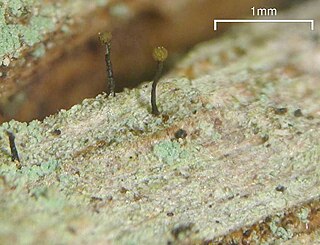
The Coniocybaceae are the sole family of lichen-forming fungi in the Coniocybales, which itself is the only order in the class Coniocybomycetes. The family was circumscribed by Heinrich Gottlieb Ludwig Reichenbach in 1837. Both the order and the class were proposed by Maria Prieto and Mats Wedin in 2013 after molecular phylogenetics analysis of various calicioid lichens showed that the Coniocybaceae represented an early diverging lineage in the inoperculate ascomycetes.
The Cephalothecaceae are a family of fungi in the class Sordariomycetes. The family was circumscribed in 1917 by Austrian naturalist Franz Xaver Rudolf von Höhnel. Species in this family are saprobic, often growing on rotten wood or on other fungi. They are known to be distributed in northern temperate regions. The family was placed in a monotypic class CephalothecalesHubka & Réblová in Index Fungorum 424: 1 (2019).
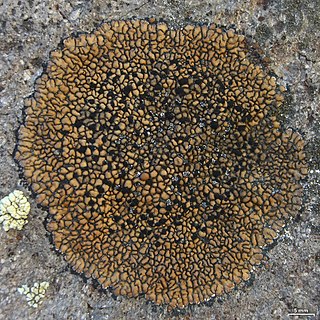
The Lecideales are an order of lichenized fungi in the class Lecanoromycetes. The order contains two families: the Lecideaceae, which contains 29 genera and about 260 species, and Lopadiaceae, which contains the single genus Lopadium of 10 species.
Gemmaspora is a single-species fungal genus of uncertain familial placement in the order Verrucariales. It contains Gemmaspora lecanorae, a lichenicolous (lichen-dwelling) fungus that parasitises the lichen genus Aspicilia. The genus was proposed in 2007 by David Hawksworth and Gökhan Halici to contain the fungus formerly known as Adelococcus lecanorae. This species, originally described by Roger-Guy Werner in 1963, occurs in Syria and Turkey.
References
- ↑ Wijayawardene, N.N.; Hyde, K.D.; Dai, D.Q.; Sánchez-García, M.; Goto, B.T.; Saxena, R.K.; et al. (2022). "Outline of Fungi and fungus-like taxa – 2021". Mycosphere. 13 (1): 53–453 [160]. doi: 10.5943/mycosphere/13/1/2 . S2CID 249054641.